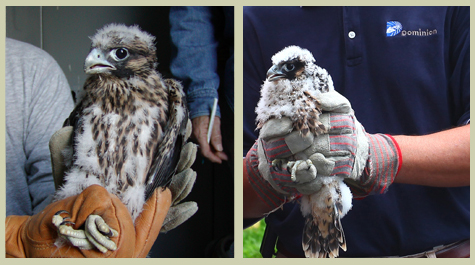W&M scientists band two peregrine falcon chicks
Normally, the birds would be banded adjacent to their nest box, but CCB researchers brought them down to the bottom of the stack to show the peregrine chicks off to representatives of media gathered to witness the event.
Bryan Watts, director of the Center for Conservation Biology, said that the chicks were the first hatched at Possum Point since the CCB installed the nest box in 1998. The Possum Point nestlings are an important part of the comeback of the falcons, which vanished as a breeding species from Virginia by the early 1960s. Last year, the CCB logged 21 breeding pairs of the raptors.
"It's pretty exciting to have these birds hatch here at Possum Point," Watts said. "We had a pair of peregrines here last year, but they got here late in the breeding season and we don't think they produced any eggs."
The College of William and Mary and its Center for Conservation Biology has been at the center of the effort to return the peregrine falcon population of Virginia since the late 1970s, when the effort used captive-raised birds, acclimated to the wild through a technique known as "hacking," then released in remote areas. Mitchell Byrd, CCB director emeritus, was a pioneer in this field and is still active in peregrine research.
The preferred situation is to let the chicks grow up in their birth nests, but Watts explained that the CCB still translocates some peregrine chicks, especially those raised in high-risk areas, such as bridges.
"Peregrines like to nest in high places like the Norris bridge near White Stone ," Watts said. "We've had a number of occasions in which the chicks seem to have fallen into the water. In cases like that we want to move those birds out of there to give them the best chance of survival."
Last year, the CCB used hacking techniques to relocate 28 young peregrines from productive, yet sometimes perilous, nest sites on the Coastal Plain and Eastern Shore. Watts explained that the birds were taken to inland sites such as Shenandoah National Park, the New River Gorge and Breaks Interstate Park in an attempt to revive the peregrine population in Virginia's mountains.
Watts said that Virginia's peregrine population is making a comeback, but that progress is slow and sometimes erratic. The first recorded breeding pair in Virginia was recorded on Assateague Island in 1982.
At present, all of the 21 known Virginia breeding pairs are nesting on the Coastal Plain-and all are using man-made structures for nests. Watts said peregrines in the wild choose natural cliff-side aeries.
















